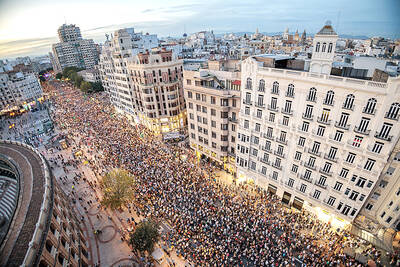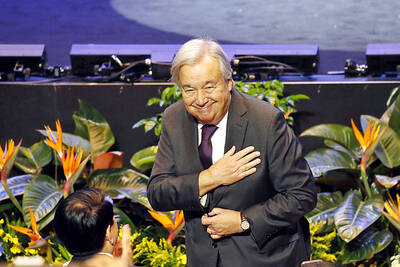Nicaragua’s leftist government, which has diplomatic relations with Taiwan, is seeking to lure investments from China — in part to offset a possible loss of support from its regional ally Venezuela.
Nicaraguan President Daniel Ortega’s government is heavily dependent on aid from fellow leftist Hugo Chavez in Venezuela, including subsidized oil and preferential terms on long-term loans.
However, Chavez faces a stiff challenge in his bid for another term in the Oct. 7 presidential election from Henrique Capriles, candidate from the unified opposition.
Even if he is re-elected, Chavez has battled with cancer for more than a year, and his health remains a question mark.
Since Ortega was re-elected in 2007 Nicaragua has received about US$2 billion in Venezuelan aid, according to official figures — and if elected, Capriles has vowed to review that aid.
“Ortega is getting prepared for a possible reduction in aid from Venezuela” given Chavez’s “uncertain” future, opposition lawmaker and ex-foreign affairs minister Victor Tinoco said.
Tinoco said the government is looking at new investors in “all the mega-projects” that it intended to pursue with Venezuelan capital.
Those projects include a US$30 billion inter-oceanic canal through Nicaragua to compete with the Panama Canal, and a US$6.5 billion petrochemical complex to refine, store and distribute fuel to all of Central America.
One possible replacement for Venezuela is China — but Nicaragua is one of 23 countries in the world that has diplomatic relations with Taiwan instead of China.
Latin America, the South Pacific and Africa have been the main battlegrounds for China and Taiwan, which have accused each other of luring allies away with “checkbook diplomacy.”
However, Managua’s ties to Taipei have not stopped Nicaragua’s interest in dealing with China.
This month, Nicaragua said it is in negotiations with China to purchase a US$300 million satellite which they hope launch into orbit by 2016.
The project, Nicasat-1, will cost approximately US$300 million. The Nicaraguan government plans to seek financing from Chinese banks, which have offered favorable interest rates.
“In mid-October of this year, the two parties are going to conclude the negotiations on all aspects of this contract,” said He Xing (何星), vice president of the Great Wall of China satellite company, on a visit to Managua.
Earlier this month, Ortega announced that a Chinese company will conduct a feasibility study on building the inter-oceanic canal.
“This is an extraordinary and very important piece of news that may affect the future not only of Nicaragua, but of Central America as a whole,” Ortega said.
The current plan calls for building a canal from Monkey Point on Nicaragua’s Caribbean coast to Puerto Corinto on the Pacific Ocean. The announcement was made after Ortega met with Chinese businessman Wan Jin (王靖), head of Xinwei Telecom, who is interested in a license to operate a mobile telephone network in Nicaragua.
Trade between the central American country of six million and the Asian giant reached US$17 million last year.
Just as the Chinese government “has shown interest in the Grand Canal project that we are proposing, we also will continue provide openings,” said Ortega’s son Laureano, an adviser to the government investment agency ProNicaragua, on the government’s official Web site.
In Latin America, countries that recognize Taiwan over China include Paraguay, Haiti and Guatemala.

DOUBLE-MURDER CASE: The officer told the dispatcher he would check the locations of the callers, but instead headed to a pizzeria, remaining there for about an hour A New Jersey officer has been charged with misconduct after prosecutors said he did not quickly respond to and properly investigate reports of a shooting that turned out to be a double murder, instead allegedly stopping at an ATM and pizzeria. Franklin Township Police Sergeant Kevin Bollaro was the on-duty officer on the evening of Aug. 1, when police received 911 calls reporting gunshots and screaming in Pittstown, about 96km from Manhattan in central New Jersey, Hunterdon County Prosecutor Renee Robeson’s office said. However, rather than responding immediately, prosecutors said GPS data and surveillance video showed Bollaro drove about 3km

‘MOTHER’ OF THAILAND: In her glamorous heyday in the 1960s, former Thai queen Sirikit mingled with US presidents and superstars such as Elvis Presley The year-long funeral ceremony of former Thai queen Sirikit started yesterday, with grieving royalists set to salute the procession bringing her body to lie in state at Bangkok’s Grand Palace. Members of the royal family are venerated in Thailand, treated by many as semi-divine figures, and lavished with glowing media coverage and gold-adorned portraits hanging in public spaces and private homes nationwide. Sirikit, the mother of Thai King Vajiralongkorn and widow of the nation’s longest-reigning monarch, died late on Friday at the age of 93. Black-and-white tributes to the royal matriarch are being beamed onto towering digital advertizing billboards, on

Tens of thousands of people on Saturday took to the streets of Spain’s eastern city of Valencia to mark the first anniversary of floods that killed 229 people and to denounce the handling of the disaster. Demonstrators, many carrying photos of the victims, called on regional government head Carlos Mazon to resign over what they said was the slow response to one of Europe’s deadliest natural disasters in decades. “People are still really angry,” said Rosa Cerros, a 42-year-old government worker who took part with her husband and two young daughters. “Why weren’t people evacuated? Its incomprehensible,” she said. Mazon’s

POWER ABUSE WORRY: Some people warned that the broad language of the treaty could lead to overreach by authorities and enable the repression of government critics Countries signed their first UN treaty targeting cybercrime in Hanoi yesterday, despite opposition from an unlikely band of tech companies and rights groups warning of expanded state surveillance. The new global legal framework aims to bolster international cooperation to fight digital crimes, from child pornography to transnational cyberscams and money laundering. More than 60 countries signed the declaration, which means it would go into force once ratified by those states. UN Secretary-General Antonio Guterres described the signing as an “important milestone,” and that it was “only the beginning.” “Every day, sophisticated scams destroy families, steal migrants and drain billions of dollars from our economy...